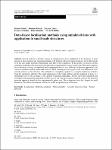Item Infomation
Full metadata record
| DC Field | Value | Language |
|---|---|---|
| dc.contributor.author | Manuel, Scholl | - |
| dc.contributor.author | Matthias, Passek | - |
| dc.contributor.author | Mirjam, Lainer | - |
| dc.date.accessioned | 2023-05-25T04:44:06Z | - |
| dc.date.available | 2023-05-25T04:44:06Z | - |
| dc.date.issued | 2023 | - |
| dc.identifier.uri | https://link.springer.com/article/10.1007/s00419-023-02388-2 | - |
| dc.identifier.uri | https://dlib.phenikaa-uni.edu.vn/handle/PNK/8509 | - |
| dc.description | CC BY | vi |
| dc.description.abstract | Several methods to localise sources of vibrations have been established in the literature. A great amount of those methods are based on databases with features of known impact positions. Great effort needs to be put into highly expensive experiments that deliver those databases. In this paper, we propose several simulation techniques that may replace the expensive experiments for source localisation. The paper compares the localisation accuracy of simulated and experimental data for two different localisation approaches, the reference database method and neural networks. Both methods process signal arrival time differences from several positions on the structure. The methods are exemplarily applied to a complex small-scale structure from the automotive industry: | vi |
| dc.language.iso | en | vi |
| dc.publisher | Springer | vi |
| dc.subject | application to small-scale structures | vi |
| dc.title | Data-based localisation methods using simulated data with application to small-scale structures | vi |
| dc.type | Book | vi |
| Appears in Collections | ||
| OER - Kỹ thuật điện; Điện tử - Viễn thông | ||
Files in This Item:

